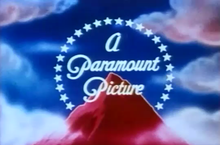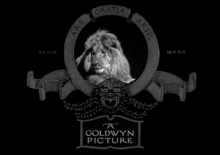Production logo
The examples and perspective in this article may not represent a worldwide view of the subject. (December 2011) |
A production logo, vanity card, vanity plate, or vanity logo is a
Production logos are becoming commonplace in
History

In the early days of

The advent of television in the 1950s also opened the door to
With the 1980s came a return to the older style of logos. Warner Bros., one of the first studios to switch to a cel-animated abstract logo, brought back their WB shield logo as a matte painting in 1984. TV logos began switching from cels and 2D computer graphics to 3D computer graphics around the same time, and by the end of the decade, the quality of 3D animation had improved to the point that cinema quality was possible. Paramount had introduced a digital-looking logo in late 1986, but only the foreground animation in their logo was computerized (the mountain backdrop was originally commissioned as a painting by the company, then a physical model made for the finished version). Universal's 1990 logo, introduced for its 75th anniversary, was pre-visualized with CG, but the actual logo was created using motion-control models. Throughout the 1990s, fully computer-generated logos increased in frequency. Disney and MGM were two of the last major studios to re-design their logos with computer animation; Disney debuted the 3D rendition of its castle logo with the release of Pirates of the Caribbean: Dead Man's Chest in 2006,[3] while MGM touched up its 1957 logo in 2012,[4] before switching to a completely computer-animated rendition by 2021.[5] Photorealistic CGI was also used in production logos, beginning with Warner Bros.' updated logo in 2021, which shows a realistic rendering of its studio lot including the iconic water tower.[6]
By 2007, almost all production logos have become produced (or edited) on computers, and have reached a level of sophistication equivalent to that of the best special effects. There are some exceptions; the
Many
See also
- Opening credits
- Closing credits
- Billing
- Motion trademark
- Audio logo
- List of filmmakers' signatures
References
- ^ "It's Surprising To See How Much The Logos Of Hollywood Movie Studios Have Changed". October 4, 2016. Archived from the original on June 13, 2018. Retrieved June 3, 2018.
- ISBN 978-1-78320-209-6. Retrieved May 6, 2019.
The visual logo had been used since 1929; a spinning globe with a radio transmitter on top, with letters spelling out A Radio Picture (until 1936) or An RKO Radio Picture (1936–56), and Morse code on the soundtrack.
- ^ "Old Disney magic in new animated logo". The Hollywood Reporter. Archived from the original on July 18, 2006. Retrieved July 10, 2006.
- ^ "MGM | Shine". shinestudio.com. Retrieved March 12, 2021.
- ^ "MGM Studios Unveils New Brand Evolution". March 8, 2021. Retrieved March 12, 2021.
- ^ "Warner Bros. Studio Logo". Devastudios. September 13, 2019. Retrieved March 12, 2021.
- ^ Malcom, Shawna (March 10, 2009). "Vanity cards let Lorre sound off". Variety. Archived from the original on May 19, 2012. Retrieved January 1, 2012.
